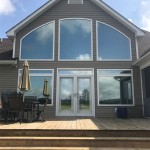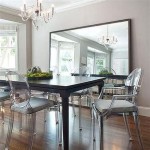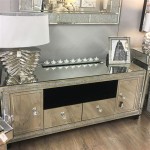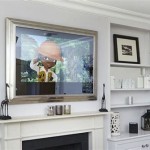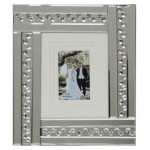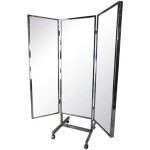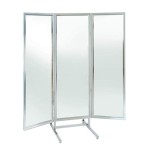The Transformative Power of Mirrors in Home Decor
Mirrors are more than mere reflective surfaces; they are powerful design elements capable of transforming the ambiance and perceived dimensions of any living space. Their versatility allows them to function as both functional necessities and aesthetic enhancements, contributing significantly to the overall harmony and visual appeal of a home. From small accent pieces to large-scale statement installations, mirrors offer a diverse range of possibilities for interior design.
The strategic placement of mirrors can manipulate light, create the illusion of spaciousness, and accentuate existing architectural features. They can also serve as a focal point, drawing the eye and adding a touch of elegance or drama to a room. Understanding the different types of mirrors available, their associated benefits, and how to incorporate them effectively is crucial for achieving the desired aesthetic and functional outcomes in home decor.
Maximizing Space and Light with Mirrors
One of the primary advantages of using mirrors in home decor is their ability to visually expand a room. This effect is particularly beneficial in smaller spaces where creating a sense of openness is paramount. By reflecting light and the surrounding environment, mirrors effectively double the perceived size of the room, making it feel more airy and less confined. A strategically placed large mirror, for instance, can make a narrow hallway appear wider or a compact living room feel more expansive.
The reflective properties of mirrors also play a crucial role in maximizing natural and artificial light. In rooms with limited natural light, mirrors can be positioned to capture and redirect sunlight, illuminating dark corners and brightening the overall atmosphere. Similarly, they can amplify the effect of artificial lighting, reducing the need for excessive light fixtures and creating a more inviting ambiance. Consider placing a mirror opposite a window to capture and distribute natural light throughout the room. In rooms with artificial lighting, strategically position mirrors to reflect the light emitted from lamps and chandeliers, creating a brighter and more inviting space.
The size and shape of the mirror also influence its ability to maximize space and light. Larger mirrors tend to create a more significant impact, visually expanding the room to a greater extent. Rectangular mirrors, especially when hung horizontally, can elongate a space, while vertical mirrors can add height to a room. The shape of the mirror should complement the overall design aesthetic of the room. A round mirror can soften the edges of a room and add a touch of elegance, while a square mirror can create a more modern and geometric feel.
Consider the placement of mirrors in relation to other design elements. Hanging a mirror behind a piece of furniture, such as a sofa or a console table, can create depth and visual interest. Placing a mirror near a doorway can make a narrow entryway feel more welcoming and spacious. Experiment with different placements to find the optimal arrangement that maximizes the benefits of the mirror in terms of space and light.
Using Mirrors as Decorative Accents
Beyond their functional benefits, mirrors serve as compelling decorative accents, adding personality and style to a home. They come in a wide array of shapes, sizes, frames, and styles, allowing homeowners to choose pieces that complement their existing decor and reflect their personal taste. From ornate antique mirrors to sleek modern designs, there is a mirror to suit every aesthetic preference.
Mirrors can be used to create a focal point in a room. A large, decorative mirror hung above a fireplace mantel or a console table instantly draws the eye and adds a touch of drama to the space. The frame of the mirror can be chosen to complement the existing decor, whether it's a rustic wooden frame for a farmhouse style or a sleek metallic frame for a modern aesthetic. The mirror can also be used to reflect a particular artwork or architectural feature, enhancing its visual impact.
Mirror groupings are another effective way to create a decorative statement. A collection of smaller mirrors of varying shapes and sizes can be arranged on a wall to create a gallery-like effect. This approach allows for greater flexibility and creativity in incorporating mirrors into the decor. The mirrors can be arranged in a symmetrical or asymmetrical pattern, depending on the desired aesthetic. Consider using mirrors with different frame styles and finishes to add visual interest to the grouping.
The placement of mirrors in relation to other decorative elements is also important. Mirrors can be used to reflect and enhance the beauty of other objects in the room, such as plants, artwork, or decorative accessories. Placing a mirror behind a vase of flowers, for example, can double the visual impact of the arrangement. Similarly, hanging a mirror opposite a piece of artwork can create a dialogue between the two elements, adding depth and complexity to the decor.
Consider the overall style of the room when choosing mirrors as decorative accents. A traditional room might benefit from an ornate antique mirror with a gilded frame, while a modern room might be better suited to a sleek frameless mirror or a minimalist geometric design. The mirror should seamlessly integrate into the existing decor, enhancing the overall aesthetic without overpowering the other elements in the room.
Types of Mirrors and Their Applications
The market offers a diverse range of mirror types, each with its unique characteristics and applications. Understanding the different types available allows for a more informed decision when selecting mirrors for home decor purposes. These types can be categorized based on their construction, style, and intended use.
Wall mirrors are the most common type of mirror and are typically hung on walls using hooks or hardware. They come in a wide variety of shapes, sizes, and frame styles, making them suitable for almost any room in the house. Full-length wall mirrors are particularly useful in bedrooms and dressing rooms, while smaller wall mirrors can be used as decorative accents in living rooms, hallways, and bathrooms. The choice of frame style should complement the overall decor of the room. Consider the size and shape of the wall space when selecting a wall mirror. A large wall mirror can make a small room feel more spacious, while a smaller wall mirror can add a touch of elegance to a corner or alcove.
Floor mirrors, also known as cheval mirrors, are freestanding mirrors that are supported by a frame or stand. They are typically full-length and are ideal for dressing rooms and bedrooms. Floor mirrors offer greater flexibility in terms of placement, as they can be easily moved around the room. Some floor mirrors have adjustable tilt, allowing for optimal viewing angles. The frame of the floor mirror can be chosen to match the existing furniture or to create a contrasting accent piece.
Vanity mirrors are specifically designed for use in bathrooms and dressing rooms. They are typically smaller in size and are often equipped with magnifying features for grooming and makeup application. Vanity mirrors can be wall-mounted, freestanding, or integrated into a vanity unit. Some vanity mirrors have built-in lighting, which can be particularly useful for tasks that require precision. The style of the vanity mirror should complement the overall design of the bathroom or dressing room.
Decorative mirrors encompass a wide range of styles and designs, from antique mirrors with ornate frames to modern mirrors with minimalist aesthetics. They are primarily used for decorative purposes, adding visual interest and personality to a room. Decorative mirrors can be hung individually or grouped together to create a gallery-like effect. The choice of decorative mirror should reflect the homeowner's personal taste and complement the existing decor of the room.
Smart mirrors are a relatively new type of mirror that incorporates technology to provide users with additional features, such as weather updates, news headlines, and access to streaming services. Smart mirrors are typically equipped with a touchscreen display and voice control capabilities. They can be used in bathrooms, dressing rooms, and bedrooms. The functionality of a smart mirror can be customized to suit the user's individual needs and preferences.
When selecting a mirror, it is essential to consider its quality and durability. Look for mirrors with high-quality glass and sturdy frames. The mirror should be free from imperfections, such as scratches or distortions. The frame should be well-constructed and resistant to damage. Investing in a high-quality mirror will ensure that it lasts for many years and continues to enhance the beauty of your home.

Burst Wall Mirrors Set Of 5 Mirror Living Room Home Decor

Modern Creative Thousand Hand Brass Wall Mirrors Home Decor Living Room Hotel Decoration China Mirror Made In Com

How To Decorate Your Living Room With Mirrors Beautiful Homes

Decorative Wall Mirrors West Elm

Top 15 Decorative Mirror Designs Mostbeautifulthings Spiegel Design Wohnen Innenarchitektur

Art Street Home Decor For Living Room Wall Hanging Rus Flower Modern Finish Decorative Mirror In Buy

100 Must See Wall Mirror Ideas For Your Home Decor

Decorative Wall Mirror Set Of 4 Hexagon For Home Dec Art Street

Teardrop Mirror Strips Ps Home Decor

27 6 Glam Metal Round Gold Wall Mirror Sun Shine Home Decor For Living Room Homary

